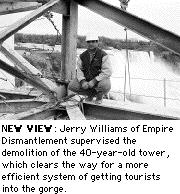
back to Niagara Falls Reporter archive
It took three years to build, and when it was done, the Observation Tower at Prospect Point stood as a 28-story monument to what passed for civic planning in Niagara Falls 40 years ago.
Decapitating and stripping down the rust-and-green monster took just three months. And when the shorter, slimmed-down structure left in its wake is complete next spring, planners hope it will be the first big step in making the Niagara Reservation State Park a more natural destination for visitors.
Work on the original tower started in 1958. Upon its completion in 1961, the boxy seven-story section that rose above Prospect Point became a lightning rod for those who want to preserve a natural feel at the oldest state park in the country and an eyesore to just about everyone else.

The steel-and-cement structure marked an early shot in the war on the beauty and history of Niagara Falls waged by city and state officials. Two decades of Urban Renewal leveled the area of the city nearest to the park, creating a cement barrier between a wonder of the world and its urban namesake.
Last spring, a federal initiative to reconnect the two Niagara Falls was announced (and a committee formed, of course). And this fall, state-backed work began on retrofitting the building that came to symbolize why tourists don't spend much time in the park or the city.
Empire Dismantlement, headed by Niagara Falls native Jerry Williams and partner Bill Wysocki, won the demolition bid at $1.3 million.
The overall project cost is expected to come in at $20 million, with various state agencies picking up half the tab and the State Power Authority splitting the rest with the owners of the Maid of the Mist, which docks at the foot of the tower.
Williams grew up in the demolition business, learning from his father, Joe Williams, and uncles Harry and Fran. Three of his four brothers also work in the industry.
"It's a captivating business," Jerry Williams said. "Once you get it in your blood, you're in it."
He's supervised demolitions all over the country, including dynamiting 1.5 million square feet worth of buildings at the Carborundum facility. He said experience gained leveling factories, water towers and smokestacks helped on this job, but the Observation Tower required an innovative approach.
First, unlike the vast majority of Empire's projects, it wasn't a total demolition -- once the portion above the deck was sheared off using torches and rigging, the tower's remaining steel skeleton had to serve as the guts of its replacement. Then there was the location -- 20 stories down a wall of rock from the crane and trucks needed to do the job.
"It's definitely in the top 10 most challenging jobs we've done, out of thousands," he said. "This was unique because everything was different at each stage. Nothing was repetitive. Every step of it involved a new plan, a new design."
He said those plans emerged from collaboration between workers.
"A lot of these guys have done a lot of big jobs in their lives," Williams said. "You bring in that veteran experience, add your own, talk through it and then make it happen."
Scaffolding surrounded the tower, with narrow, steep aluminum stairs taking workers up and down. A plastic sheath kept moisture out of the work area and, along with immense ventilation tubes, kept lead paint chips and asbestos from escaping.
To pull the larger debris out of the gorge and lower equipment into it, Williams brought in a crane with a 375-foot boom capable of lifting up to 35 tons. With working by sight impossible, the crane operator had to receive radio instructions from the crew below.
At the bottom, there was plenty of torch work and a fair amount of heavy lifting. Williams' crew, composed of Empire employees and members of Ironworkers Local 9, cut away more than 300 tons of steel and loaded it into roll-off containers provided by Ange's Scrap Iron, which hauled them away.
"We designed the whole demolition around those containers," Williams said.
Steel made up the least of the material to be removed, with 1,500 tons of concrete and 700 tons of stone also getting hoisted out by crane to make room for new, high-speed elevators.
Diesel-powered saws cut through six-foot slabs of concrete. Workers then drilled through the concrete and inserted steel rods to give the crane a grip on pieces weighing up to six tons each.
In all, Empire Dismantlement cleared a 3,000-square-foot area at the base of the tower. When the project is complete, four elevators encased in transparent glass will transport tourists to and from the bottom of the gorge and the Maid of the Mist boats.
"I think it's going to be beautiful when it's done," Williams said.
Now there's something it's hard to imagine anyone saying about its predecessor.